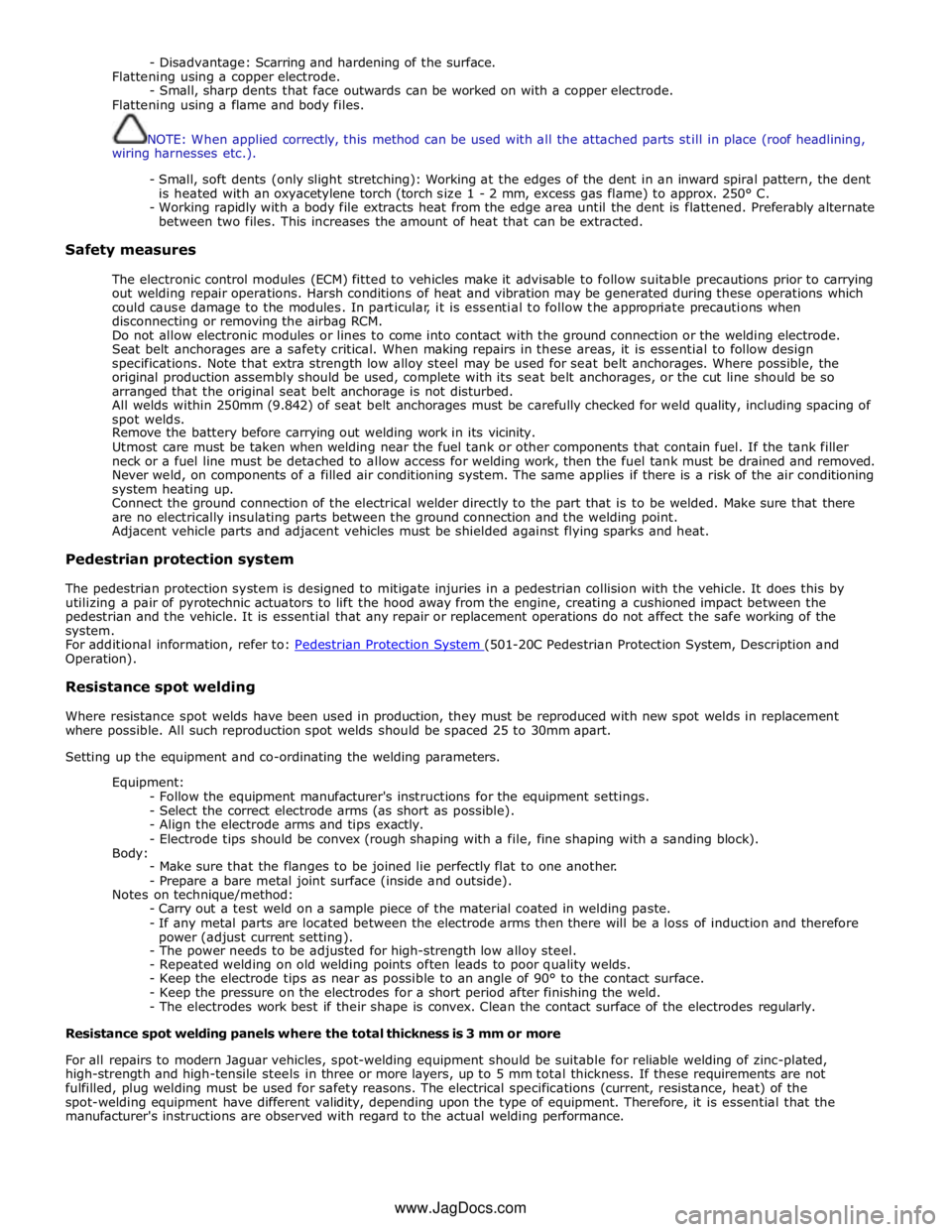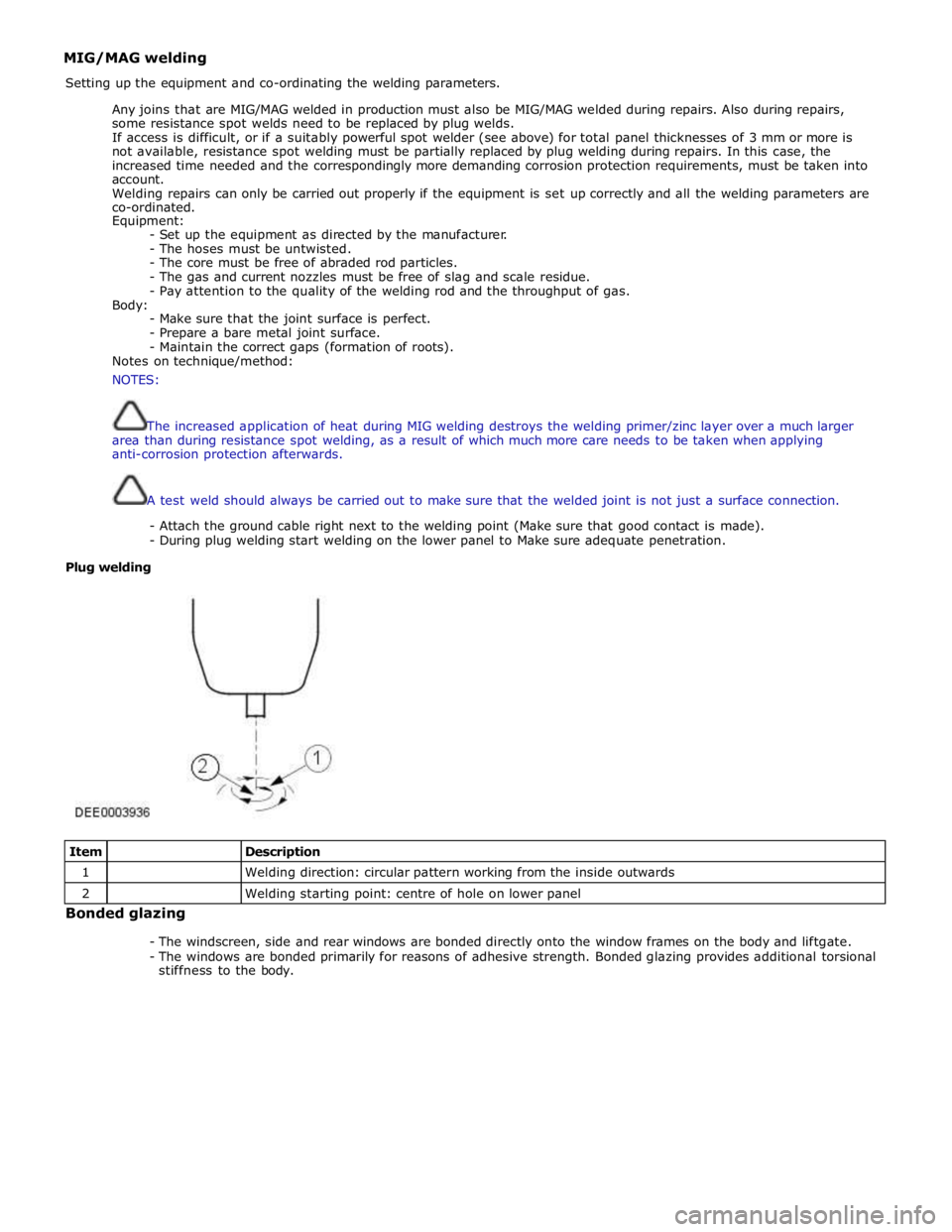2010 JAGUAR XFR lug pattern
[x] Cancel search: lug patternPage 2714 of 3039

- Disadvantage: Scarring and hardening of the surface.
Flattening using a copper electrode.
- Small, sharp dents that face outwards can be worked on with a copper electrode.
Flattening using a flame and body files.
NOTE: When applied correctly, this method can be used with all the attached parts still in place (roof headlining,
wiring harnesses etc.).
- Small, soft dents (only slight stretching): Working at the edges of the dent in an inward spiral pattern, the dent
is heated with an oxyacetylene torch (torch size 1 - 2 mm, excess gas flame) to approx. 250° C.
- Working rapidly with a body file extracts heat from the edge area until the dent is flattened. Preferably alternate
between two files. This increases the amount of heat that can be extracted.
Safety measures
The electronic control modules (ECM) fitted to vehicles make it advisable to follow suitable precautions prior to carrying
out welding repair operations. Harsh conditions of heat and vibration may be generated during these operations which
could cause damage to the modules. In particular, it is essential to follow the appropriate precautions when
disconnecting or removing the airbag RCM.
Do not allow electronic modules or lines to come into contact with the ground connection or the welding electrode.
Seat belt anchorages are a safety critical. When making repairs in these areas, it is essential to follow design
specifications. Note that extra strength low alloy steel may be used for seat belt anchorages. Where possible, the
original production assembly should be used, complete with its seat belt anchorages, or the cut line should be so
arranged that the original seat belt anchorage is not disturbed.
All welds within 250mm (9.842) of seat belt anchorages must be carefully checked for weld quality, including spacing of
spot welds.
Remove the battery before carrying out welding work in its vicinity.
Utmost care must be taken when welding near the fuel tank or other components that contain fuel. If the tank filler
neck or a fuel line must be detached to allow access for welding work, then the fuel tank must be drained and removed.
Never weld, on components of a filled air conditioning system. The same applies if there is a risk of the air conditioning
system heating up.
Connect the ground connection of the electrical welder directly to the part that is to be welded. Make sure that there
are no electrically insulating parts between the ground connection and the welding point.
Adjacent vehicle parts and adjacent vehicles must be shielded against flying sparks and heat.
Pedestrian protection system
The pedestrian protection system is designed to mitigate injuries in a pedestrian collision with the vehicle. It does this by
utilizing a pair of pyrotechnic actuators to lift the hood away from the engine, creating a cushioned impact between the
pedestrian and the vehicle. It is essential that any repair or replacement operations do not affect the safe working of the
system.
For additional information, refer to: Pedestrian Protection System (501-20C Pedestrian Protection System, Description and Operation).
Resistance spot welding
Where resistance spot welds have been used in production, they must be reproduced with new spot welds in replacement
where possible. All such reproduction spot welds should be spaced 25 to 30mm apart.
Setting up the equipment and co-ordinating the welding parameters.
Equipment:
- Follow the equipment manufacturer's instructions for the equipment settings.
- Select the correct electrode arms (as short as possible).
- Align the electrode arms and tips exactly.
- Electrode tips should be convex (rough shaping with a file, fine shaping with a sanding block).
Body:
- Make sure that the flanges to be joined lie perfectly flat to one another.
- Prepare a bare metal joint surface (inside and outside).
Notes on technique/method:
- Carry out a test weld on a sample piece of the material coated in welding paste.
- If any metal parts are located between the electrode arms then there will be a loss of induction and therefore
power (adjust current setting).
- The power needs to be adjusted for high-strength low alloy steel.
- Repeated welding on old welding points often leads to poor quality welds.
- Keep the electrode tips as near as possible to an angle of 90° to the contact surface.
- Keep the pressure on the electrodes for a short period after finishing the weld.
- The electrodes work best if their shape is convex. Clean the contact surface of the electrodes regularly.
Resistance spot welding panels where the total thickness is 3 mm or more
For all repairs to modern Jaguar vehicles, spot-welding equipment should be suitable for reliable welding of zinc-plated,
high-strength and high-tensile steels in three or more layers, up to 5 mm total thickness. If these requirements are not
fulfilled, plug welding must be used for safety reasons. The electrical specifications (current, resistance, heat) of the
spot-welding equipment have different validity, depending upon the type of equipment. Therefore, it is essential that the
manufacturer's instructions are observed with regard to the actual welding performance.
www.JagDocs.com
Page 2715 of 3039

MIG/MAG welding
Setting up the equipment and co-ordinating the welding parameters.
Any joins that are MIG/MAG welded in production must also be MIG/MAG welded during repairs. Also during repairs,
some resistance spot welds need to be replaced by plug welds.
If access is difficult, or if a suitably powerful spot welder (see above) for total panel thicknesses of 3 mm or more is
not available, resistance spot welding must be partially replaced by plug welding during repairs. In this case, the
increased time needed and the correspondingly more demanding corrosion protection requirements, must be taken into
account.
Welding repairs can only be carried out properly if the equipment is set up correctly and all the welding parameters are
co-ordinated.
Equipment:
- Set up the equipment as directed by the manufacturer.
- The hoses must be untwisted.
- The core must be free of abraded rod particles.
- The gas and current nozzles must be free of slag and scale residue.
- Pay attention to the quality of the welding rod and the throughput of gas.
Body:
- Make sure that the joint surface is perfect.
- Prepare a bare metal joint surface.
- Maintain the correct gaps (formation of roots).
Notes on technique/method:
NOTES:
The increased application of heat during MIG welding destroys the welding primer/zinc layer over a much larger
area than during resistance spot welding, as a result of which much more care needs to be taken when applying
anti-corrosion protection afterwards.
A test weld should always be carried out to make sure that the welded joint is not just a surface connection.
- Attach the ground cable right next to the welding point (Make sure that good contact is made).
- During plug welding start welding on the lower panel to Make sure adequate penetration.
Plug welding
Item
Description 1
Welding direction: circular pattern working from the inside outwards 2
Welding starting point: centre of hole on lower panel Bonded glazing
- The windscreen, side and rear windows are bonded directly onto the window frames on the body and liftgate.
- The windows are bonded primarily for reasons of adhesive strength. Bonded glazing provides additional torsional
stiffness to the body.